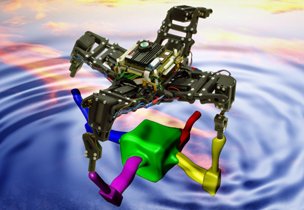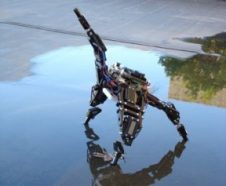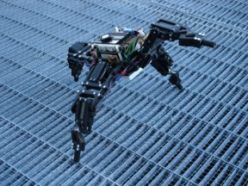Nonstop Robot
A new, four-legged robot can recover from damage to its own body and keep on walking.
By Emily Sohn
In some of the scariest science fiction scenarios, evil robots refuse to die, no matter how fiercely people fight back.
Now, science fiction has edged into science fact. For the first time, researchers have created a robotic machine that can take a beating and keep on trucking. Developed by scientists from Cornell University and the University of Vermont, the new robot looks like a spider with four legs.
 |
|
In this illustration, a newly developed robot stands over water in which the machine’s reflection is a colorful block figure. By picturing and using this block figure as a simple model of itself, the gizmo can adapt to damage more easily than ordinary robots do.
|
| © Science |
Until now, even the most advanced robot was almost certain to break down when damaged. That’s because its internal computer simply doesn’t know how to operate the machine after its shape has changed.
To get around this problem, the spidery robot’s developers equipped their invention with eight motors and two sensors that read how the machine is tilting. The motors and sensors all provide electrical signals to the machine’s software.
 |
|
This four-legged robot can teach itself to walk, even changing how it walks after it has suffered damage.
|
| © Science |
Using this information, the system follows a new procedure to figure out the machine’s shape at any given moment. The program chooses from among 100,000 possible arrangements of parts.
From there, the computer considers a wide variety of possible next steps, and it calculates how best to move the robot forward the longest possible distance, before trying to move again.
 |
|
This robot can sense and recover from damage to its own body.
|
| © Science |
The new strategy is a major advance in robotics, scientists say, and it’s far from scary. The technology may someday help researchers create better artificial limbs that give new freedom to people who lack arms and legs. The new knowledge might also help scientists understand how people and animals figure out their own sense of place in space.
“Designing robots that can adapt to changing environments and can compensate for damage has been a difficult problem,” says neuroscientist Olaf Sporns of Indiana University in Bloomington. “This work provides a new way toward solving this important problem.”—E. Sohn
Going Deeper:
Weiss, Peter. 2006. Unstoppable bot: Armed with self-scrutiny, a mangled robot moves on. Science News 170(Nov. 18):324-325. Available at http://www.sciencenews.org/articles/20061118/fob3.asp .
Sohn, Emily. 2006. Shape shifting. Science News for Kids (May 17). Available at http://www.sciencenewsforkids.org/articles/20060517/Feature1.asp .
______. 2005. Machine copy. Science News for Kids (May 18). Available at http://www.sciencenewsforkids.org/articles/20050518/Note3.asp .
Webb, Sarah. 2006. Dancing with robots. Science News for Kids (May 10). Available at http://www.sciencenewsforkids.org/articles/20060510/Feature1.asp .
______. 2005. Roboroach and company. Science News for Kids (Sept. 7). Available at http://www.sciencenewsforkids.org/articles/20050907/Feature1.asp .







